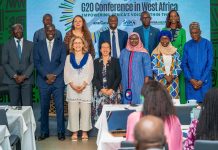By Samantha Linda
With funding for global health declining, world leaders have been urged to act now or risk reversing decades of progress in saving children’s lives.
“Humanity is at a crossroads. With millions of children’s lives on the line, global leaders have a once-in-a-generation chance to do something extraordinary,” Bill Gates, Gates Foundation Chair, said during the 2025 Goalkeepers event in New York.
“The choices they make now-whether to go forward with proposed steep cuts to health aid or to give the world’s children the chance they deserve to live a healthy life-will determine what kind of future we leave the next generation.”
The caution comes against sobering statistics. According to new data from the Institute for Health Metrics and Evaluation (IHME), development assistance for health (DAH) has dropped by 21% between 2024 and 2025, reaching its lowest level in 15 years. If maintained, these cuts could unravel gains that halved child mortality since 2000 from 10 million to under 5 million deaths annually.
Despite the bleak funding picture, Gates emphasized that solutions exist. A new analysis by IHME and the Gates Foundation shows that sustained investments, combined with scaling affordable innovations, could cut child deaths in half again by 2045.
To underscore his commitment, Gates announced a $912 million pledge to the Global Fund’s 2026–2028 replenishment, bringing the Foundation’s total contributions since 2002 to $4.9 billion. The funding will go towards fighting AIDS, malaria and tuberculosis (TB).
The hope, he said, is to galvanize governments and philanthropists to match or exceed this commitment during the replenishment cycle co-hosted by South Africa and the UK later this year.
“An entire generation is alive today thanks to the world’s generosity, smart investments, and hard work of governments and Global Fund partners,” Gates said. “Now we must go further so the next generation grows up in a world where no child dies from preventable causes.”
The Gates Foundation outlined a roadmap for saving the lives of children across the world. First, leaders must renew investments in proven initiatives such as the Global Fund and Gavi, the Vaccine Alliance, which continue to deliver strong returns; the Global Fund alone has saved more than 70 million lives since 2002, with every dollar invested yielding an estimated $19 in health and economic benefits.
Second, countries need to strengthen primary health systems, ensuring that even in times of fiscal strain, frontline care is prioritized, since early detection and treatment of childhood illnesses remain the cheapest and most effective life-saving strategies.
Finally, scaling breakthrough innovations will be critical, with an expanding pipeline that includes single-dose malaria treatments, mosquito-targeted interventions, long-acting HIV drugs, maternal vaccines against RSV and GBS, and AI-driven health delivery systems that can lower costs and expand access to care.
“These are not futuristic dreams,” Gates stressed. “They are real innovations already saving lives. The question is whether governments will give them the support they need to scale.”
The event also recognized leaders advancing child survival. Spanish Prime Minister, Pedro Sánchez received the 2025 Global Goalkeeper Award for expanding Spain’s contributions to the Global Fund and Gavi. Ten other champions, including Dr. Abhay and Rani Bang (India), Jerop Limo (Kenya), Krystal Mwesiga Birungi (Uganda), and David Beckham (UK) were celebrated for their grassroots innovations, advocacy, and global influence.
Beyond the pledges and awards, the Goalkeepers event delivered a stark reminder: the world’s health security and economic stability are tied to child survival. Shrinking investments now risk future costs many times higher.
As Dawda Jobarteh, deputy director of the foundation’s campaign, put it: “Together, we can reimagine a future without preventable child deaths and unlock the next wave of breakthroughs for the world’s children.”
The Gates Foundation will release its 2025 Goalkeepers Report later this year, detailing how decisions made in the coming months could set the trajectory for children’s health worldwide.






